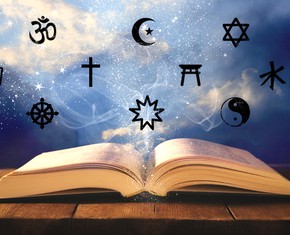The views expressed in our content reflect individual perspectives and do not represent the authoritative views of the Baha'i Faith.
So far, in this “Figuring Out Prophecy” series, we have looked at apocalyptic texts from several world religions.
Those texts offer visions of the future, whether imagined or truly foreseen in some kind of mystic vision.
In those visions we have seen various messianic figures foretold in the various world religions, such as: (1) the return of Jesus Christ; (2) “meeting God” on the Day of Judgment, as foretold in the Qur’an; (3) the appearance of Kalki Visnuyasas, the Hindu Messiah; (4) the descent of Maitreya, the future Buddha; (5) and the arrival of Shah Bahram Varjavand, the Zoroastrian savior-figure, among others.
At this point in the series, I’d like to offer a few general conclusions and insights. By way of a disclaimer, the insights that I’m about to share with you are purely individual, and do not represent any official position on the part of the Baha’i Faith.
Over time, as I studied the prophecies of the world’s great Faiths, I gradually came to see these apocalyptic traditions as products of their respective times and places, projected as an end-times drama onto the world stage in the distant future. This growing realization is the product of a lot of thinking, of reading and rereading the texts themselves, of immersing myself in their commentaries by various interpreters, and in consulting a fair amount of scholarship as well. So let me begin with the following statement, in the form of a general proposition: “Prophecy is far more predicative than predictive.” Says who?
I was surprised to run across this statement in an old paper that I completed on June 15, 1980, and presented to a conference of the American Academy of Religion in May 1981. I was 29 back then, but after all these years, I still stand by that statement.
Obviously prophecies predict—but their predictions are largely the product of their time and place. An oppressed people, at the time that a certain apocalypse was written, may have longed for a messianic liberator who would vanquish the oppressors. This is a natural, even predictable reaction to living under conquest in times of duress and economic stress. Several previous articles in this series have given examples of such apocalyptic scenarios, some of which were clearly written after the conquests they describe.
Prophecies have the function of pointing the way forward. They create expectations. They hope for a better world. At times, their descriptions of the future decline of society are uncanny in their accuracy:
In the divine Holy Books there are unmistakable prophecies giving the glad tidings of a certain Day in which the Promised One of all the Books would appear, a radiant dispensation be established, the banner of the Most Great Peace and conciliation be hoisted and the oneness of the world of humanity proclaimed. Among the various nations and peoples of the world no enmity or hatred should remain. All hearts were to be connected one with another. These things are recorded in the Torah, or Old Testament, in the Gospel, the Qur’an, the Zend-Avesta, the books of Buddha and the book of Confucius. In brief, all the Holy Books contain these glad tidings. They announce that after the world is surrounded by darkness, radiance shall appear. For just as the night, when it becomes excessively dark, precedes the dawn of a new day, so likewise when the darkness of religious apathy and heedlessness overtakes the world, when human souls become negligent of God, when materialistic ideas overshadow spirituality, when nations become submerged in the world of matter and forget God — at such a time as this shall the divine Sun shine forth and the radiant morn appear. – Abdu’l-Baha, The Promulgation of Universal Peace, pp. 220-221.
At other times, some prophecies are wildly speculative, and are basically impossible of realistic fulfillment. Nor would we want any symbolic prophecy to be fulfilled purely on its own literal terms, especially if massive death and destruction are involved. There must be a better way. Prophecies call for deliverance, justice, and a better world. If a messianic claimant can do better than the prophetic texts themselves, then more power to that messianic claimant!
This is basically what Baha’u’llah has done. He has not followed any prophetic “script.” Although prophecies, generally speaking, endeavored to “write the future,” whatever future they have written, Baha’u’llah has rewritten.
It’s easy to point out that Baha’u’llah has not fulfilled most prophecies literally. Baha’u’llah’s fulfillment of these messianic traditions is spiritual and symbolic. This is all the more well and good, even necessary, given the limited visions of the prophecies themselves—including the sometimes objectionable (by today’s standards) scenarios that such prophecies may portray and project into the distant future.
Examples from prophecies could be multiplied. But if some of the general principles presented in this “Figuring Out Prophecy” series are taken seriously, they can easily be applied to just about any prophetic tradition.
There’s nothing magical about prophecies. They are essentially religious mandates for the future appearance of a savior figure. Every Faith has them. Naturally, prophecies in any given tradition tend to be products of religious nationalism or exceptionalism, and are often ethnocentric and sectarian by nature. Why would anyone want to see those prophecies fulfilled, especially if our goal today is to bring about a world of peace, justice, and equality of opportunity?
Many apocalyptic traditions simply do not fit the bill of universal peace and justice. They may talk about justice, but they do not teach real justice. This is especially true if the apocalyptic scenario is simply that of a conqueror, whose “might makes right.” But in most prophecies, the conqueror typically has nothing to say, nothing to teach, nothing new to reveal, and no blueprint for good governance.
When investigating Baha’u’llah’s fulfillment of prophetic truth-claims, there is good reason not to judge Baha’u’llah’s claims by the prophecies themselves. As demonstrated in the previous articles in this series, prophecies are generally not reliable, except in the most general of terms. To their credit, prophecies create a forward-looking expectation. They endow the future with a teleological (purpose-driven) dimension. In other words, history is seen as a process of social evolution, although such a concept may have been too abstract in antiquity to be seen in quite this way.
Suffice it to say that prophecies, at best, are more predicative than predictive. To “predicate,” according to one of the definitions in the Oxford English Dictionary, is to “assert or affirm as a quality, property, or attribute of.” Here, prophecies, generally speaking, “assert or affirm as a quality, property, or attribute of” a messianic figure in the eschatological future.
In other words, conditions are set, and are fulfilled when met.
Time will tell. Such prophecies will not automatically come true. Simply stating that certain prophecies may point to a specific time and date is not enough. Timing alone is no guarantor that the conditions mandated by any given prophecies will actually happen at that particular time. Such attractive possibilities, in an of themselves, do not guarantee real outcomes.
Another important principle in evaluating prophecies is to understand that they are not, should not, and cannot operate as specific requirements for their own fulfillment. It is far more realistic that prophecies be regarded as religious and social mandates for bringing about a better world.
Taken together, the prophecies of various world religions may be seen as glimpses of the future. These limited previews of the future are convergent in nature. In other words, the sundry prophecies of the world’s religions impart a shared, collective vision of a future in which the world will evolve into a millennial paradise—that is, a world characterized by justice, peace and prosperity.
Although different messiahs are foretold, their names are not important. It’s what the World-Messiah does that counts. That’s why Baha’u’llah is associated with several messianic traditions at once—something that I have called a “multiple-messiahship.”
We also need to disencumber ourselves from the idea that the World-Messiah will change everything all at once. Such is not the case. For our own spiritual growth and enlightenment, we must carry out the teachings of the World-Messiah as best we can, in order to bring about the fulfillment of those social principles and teachings.
The prophets and seers of old—in a colorful, vivid, yet circumscribed way—each had something to say. Each visionary medium imparts an implicit social message.
So prophecies, if taken literally, actually prevent their own fulfillment. It’s time to realize that prophecies have their own limitations, and that we should therefore not be limited by them.
The prophecies of the various world religions make a lot more sense when compared with each other and, in a sense, read together as part of a shared vision. Their vision is shared because human hopes and aspirations for a better world are universal in nature and in scope.
It took me many years of study to arrive at these insights, which I now share with you in an article that you can read in just a few minutes. Thank you for your time in reading about the end times.
















Comments
Sign in or create an account
Continue with Googleor